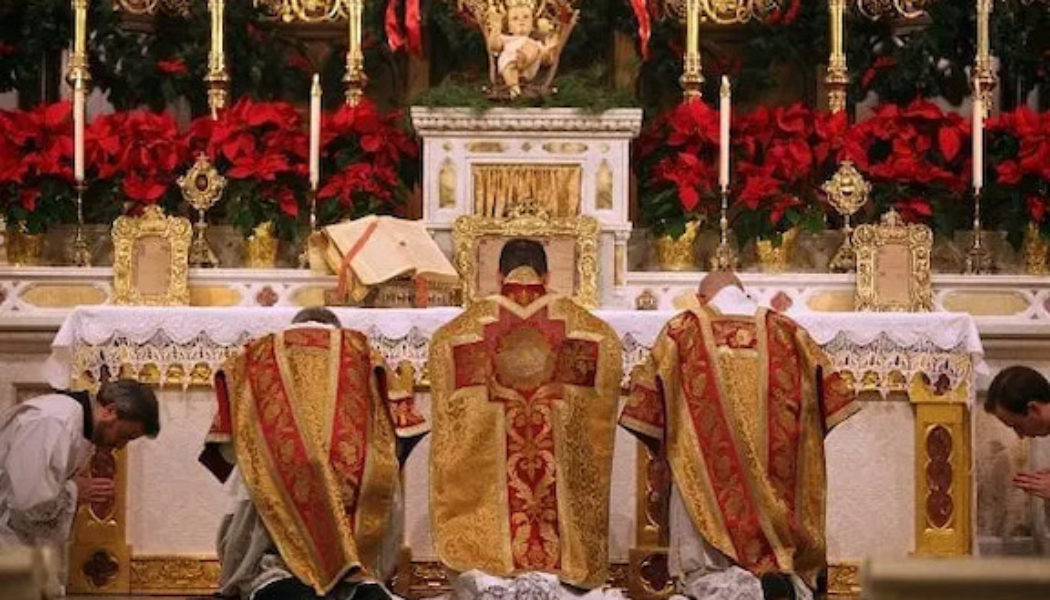Pope Francis, in an effort to unite the liturgical camps of the Catholic Church, has accused those who attend the Latin rite of a variety of sins, including one that grieves the Holy Spirit most deeply, that of not believing in the doctrines that came from the Second Vatican Council. The Holy Father says that we must be one in our worship as we are one in our belief. Hence the motu proprio, “Guardians of Tradition” (Traditionis Custodes).
I attend Mass in the new order. On the very rare occasions when I have attended the Latin Mass, I knew what I was getting. I might be from the other side of the world, and I would feel at home. Unity in creed is reflected by unity in worship. But with the Novus Ordo, it is another matter.
I shall illustrate, from experience, changing the names, lest I seem to be glancing at anyone in particular.

Here we are at Saint John’s. We have a genuine organist who plays a prelude and a postlude, and who leads two singers (with his own bass to accompany them) in music when the people are proceeding to Communion and have thus no opportunity to sing. The pastor chooses four hymns every week, and they are all traditional hymns, that is to say, real hymns and not cheap imitations or worse. There are three to seven altar servers in the sanctuary. The pastor says the Eucharistic prayer ad orientem.
The service music is classical, and is chosen for the liturgical season. During Advent, Lent, Christmastide, and Eastertide, the prayers are chanted in Latin. In Advent and Lent, you will recognize almost the only Gregorian chant that most American Catholics know, the Sanctus and the Agnus Dei from the old Mass for the Dead. But in the joyful seasons, the chants are joyful, in a major key.
Now then, you cross the street to Saint Mark’s, and things are different. There, the music is the pseudo-folk stuff from the Gather hymnal, and you are led by a soprano cantor in full sight, belting things out into a microphone. You can hardly hear the voices of anyone near you, supposing they are singing at all. Very few men – and no boys – sing. There aren’t any other obvious offenses against art. The Mass is somewhat informal, and people dress casually. You think, “If only these good folks knew what a hymn was.” There are two altar servers, a girl and a boy, and they actually do a few things.

Then you go to the next neighborhood, still in the same city, and you see right away that you failed to do due diligence. It’s the hoary rock Mass. A couple of the songs are not hymns at all, but contemporary mantra things. The words are beamed by a projector onto the wall above the altar. They do not bear punctuation. Since such music works mainly by decibels, everything else is drowned out. The instruments up front include an electric piano and drums. Still, the preacher is orthodox, and if you had arrived two hours later, the piano and drums would not be there.
Across town is Saint Anthony’s. You can hardly slip into Saint Anthony’s past the sentries at the door, the “greeters.” Whatever they may intend, they make you feel self-conscious. That continues once you are inside. Some minister of this or that announces herself, gives the name of the altar server if there is one (there often is not, and if there is, she is given nothing to do but look bored), the names of the readers, the names of the helpers at Communion, and the name of the priest. To your mounting horror, she begins her final sentence with the words, “And now” – and you pretend not to hear, because you hate the false bonhomie, shaking hands with strangers and telling them your name. Young people at Saint Anthony’s are hard to find. Once a boy reaches the age of twelve, he puts babyish things aside. Latin hasn’t been heard at Saint A’s in sixty years. Most of the parishioners have no idea what Benediction is.

You won’t hear any heresy at Saint Anthony’s. For that, you go to Our Lady of Fatima. Things don’t look good when you drive into the parking lot and see a sign announcing a “community” rather than a church. The word suggests the opposite: We are our own thing. The priest works subtly, in Fatima. He does not deny the miracles of Jesus. He simply assumes that the Gospels are exaggerations. He tells you what the “deeper meanings” of the Gospels are, which meanings he picked up thirty years ago in a seminary course. He doesn’t like to talk about how strange and challenging the words of Jesus are. He removes their teeth. As long as you profess the right political opinions, and you are a friendly fellow – which depends more on your digestive tract than upon moral courage – you can be a Christian in good standing. The banners on the wall tell you so. Don’t worry about your knees.
The sheer variety of these experiences, some incompatible with others, is the result of the choices of the people who run the parishes, and by no means are they always the pastors. In other words, each parish operates by its own motu proprio.
You’re visiting a strange town, it is Sunday, you go to the Catholic church, and you have no idea what you are getting. You do not know what motu proprio will be in force.
The faithful do not conclude that liturgy enlists man’s creative powers at their highest. They conclude that the liturgy may be thus or so, ad libitum. It is a matter of indifference. Many of them then fall into their own motu proprio and stay home and sleep late. Nor do they feel guilty about it. If liturgy may be thus or so, why not belief too? Arbitrium orandi, arbitrium credendi.
You may also enjoy:
Fr. Gerald E. Murray’s Is This What the Church Needs Just Now?
Brad Miner’s Francis Fatigue
Join Our Telegram Group : Salvation & Prosperity








